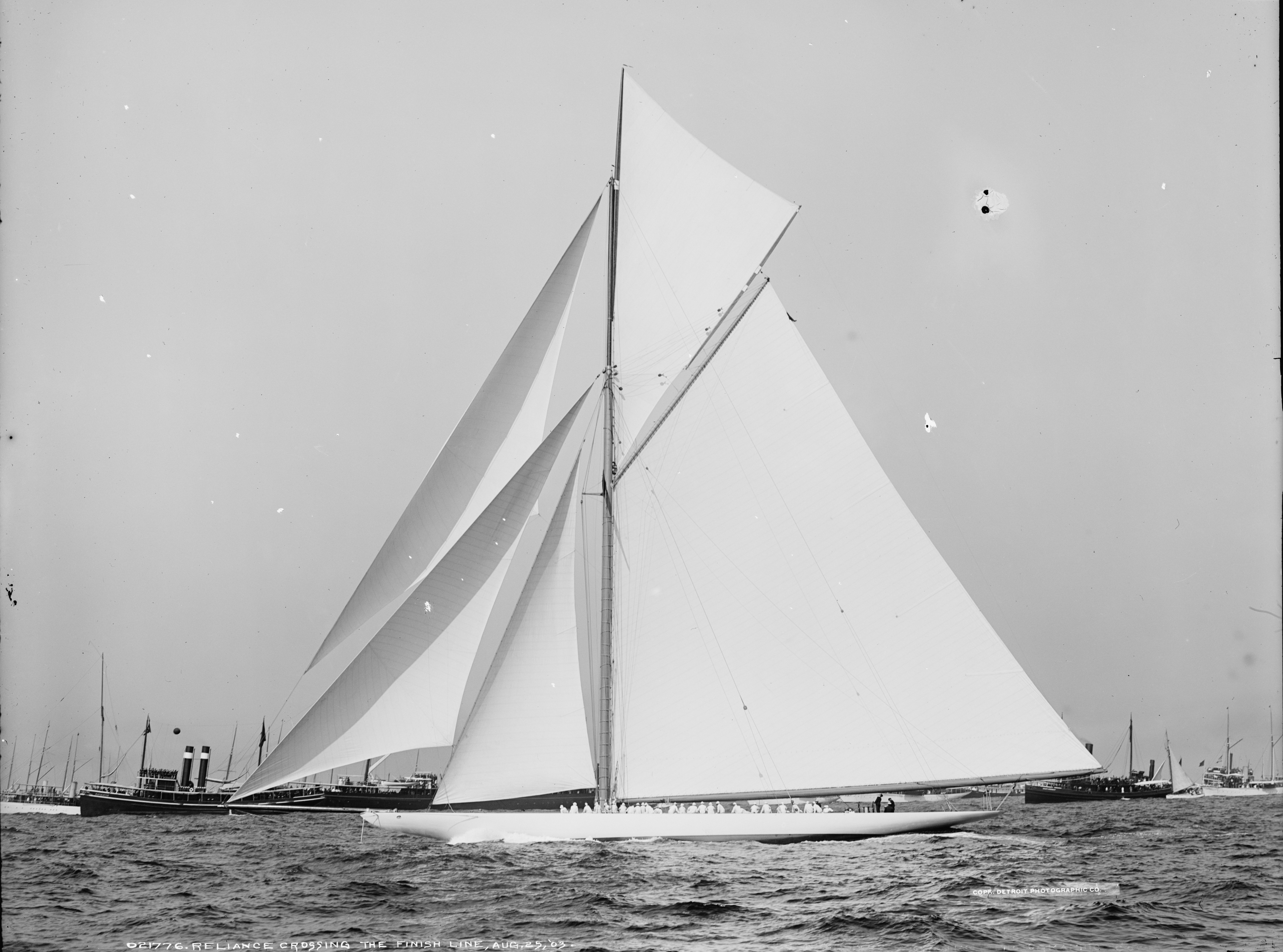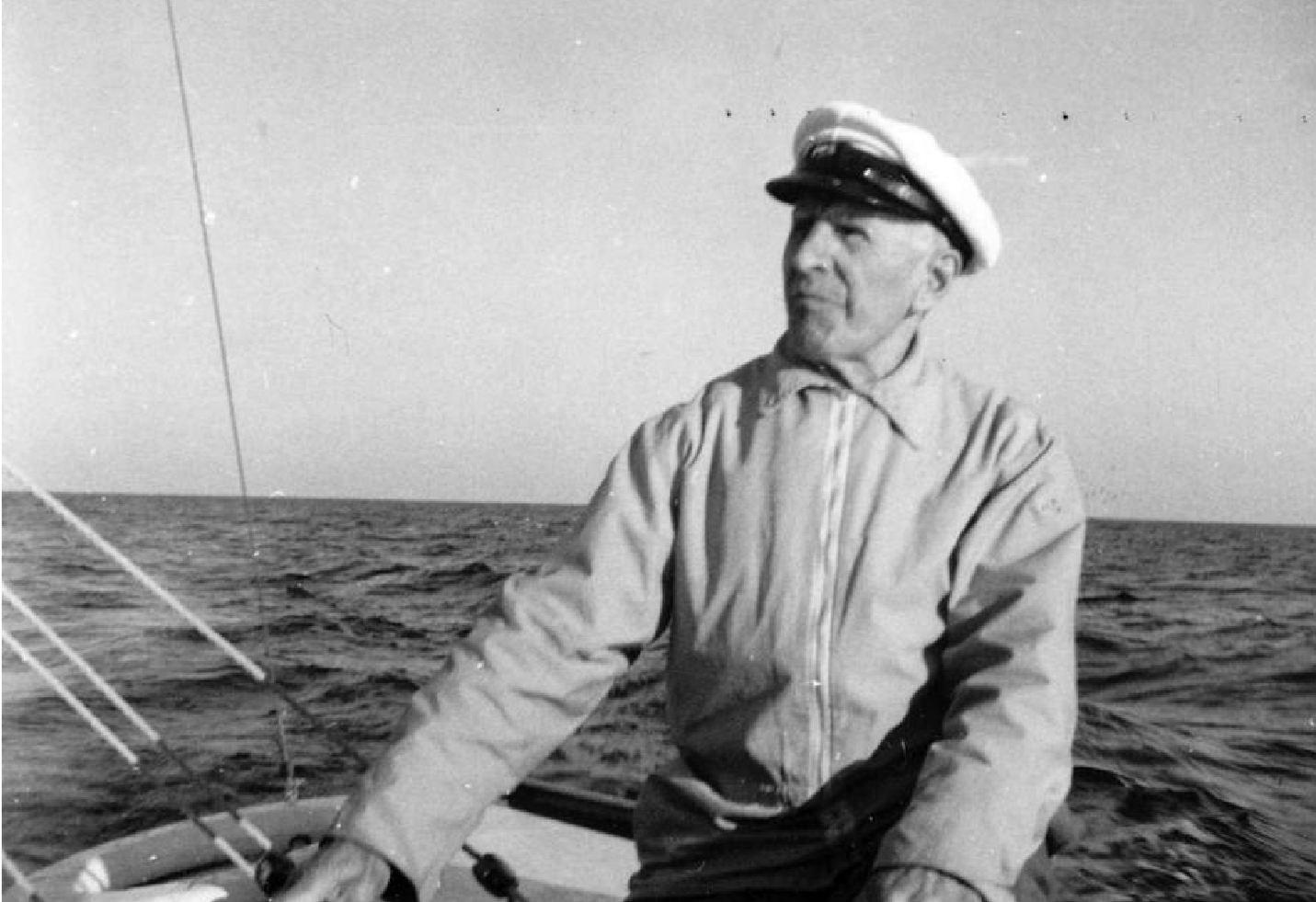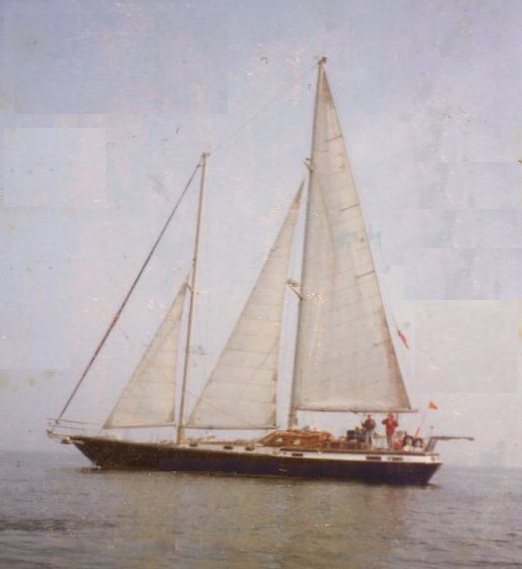|
Schooner
A schooner ( ) is a type of sailing ship, sailing vessel defined by its Rig (sailing), rig: fore-and-aft rigged on all of two or more Mast (sailing), masts and, in the case of a two-masted schooner, the foremast generally being shorter than the mainmast. A common variant, the topsail schooner also has a square topsail on the foremast, to which may be added a Topgallant sail, topgallant. Differing definitions leave uncertain whether the addition of a Course (sail), fore course would make such a vessel a brigantine. Many schooners are Gaff rig, gaff-rigged, but other examples include Bermuda rig and the staysail schooner. Etymology The term "schooner" first appeared in eastern North America in the early 1700s. The term may be related to a Scots language, Scots word meaning to skip over water, or to skip stones. History The exact origins of schooner rigged vessels are obscure, but by early 17th century they appear in paintings by Dutch marine artists. The earliest known il ... [...More Info...] [...Related Items...] OR: [Wikipedia] [Google] [Baidu] [Amazon] |
Pilot Boat
A pilot boat is a type of boat used to transport maritime pilots between land and the inbound or outbound ships that they are piloting. Pilot boats were once sailing boats that had to be fast because the first pilot to reach the incoming ship got the business. Today, pilot boats are scheduled by telephoning the ship agents/representatives prior to arrival. History Pilots and the work functions of the maritime pilot go back to Ancient Greece and Ancient Rome, Roman times, when incoming ships' captains employed locally experienced harbour captains, mainly local fishermen, to bring their vessels safely into port. Eventually, in light of the need to regulate the act of pilotage and ensure pilots had adequate insurance, the harbours themselves licensed pilots for each harbour. Although licensed by the harbour to operate within their jurisdiction, pilots were generally self-employed, meaning that they had to have quick transport to get them from the port to the incoming ships. As p ... [...More Info...] [...Related Items...] OR: [Wikipedia] [Google] [Baidu] [Amazon] |
Gaff Rig
Gaff rig is a sailing rig (configuration of sails, mast and stays) in which the sail is four-cornered, fore-and-aft rigged, controlled at its peak and, usually, its entire head by a spar (pole) called the ''gaff''. Because of the size and shape of the sail, a gaff rig will have running backstays rather than permanent backstays. The gaff enables a fore-and-aft sail to be four sided, rather than triangular. A gaff rig typically carries 25 percent more sail than an equivalent Bermuda rig for a given hull design. A sail hoisted from a gaff is called a gaff-rigged sail. Description Gaff rig remains the most popular fore-aft rig for schooner and barquentine mainsails and other course sails, and spanker sails on a square rigged vessel are always gaff rigged. On other rigs, particularly the sloop, ketch and yawl, gaff rigged sails were once common but have now been largely replaced by the Bermuda rig sail, which, in addition to being simpler than the gaff rig, usually all ... [...More Info...] [...Related Items...] OR: [Wikipedia] [Google] [Baidu] [Amazon] |
Sailing Ship
A sailing ship is a sea-going vessel that uses sails mounted on Mast (sailing), masts to harness the power of wind and propel the vessel. There is a variety of sail plans that propel sailing ships, employing Square rig, square-rigged or Fore-and-aft rig, fore-and-aft sails. Some ships carry square sails on each mast—the brig and full-rigged ship, said to be "ship-rigged" when there are three or more masts. Others carry only fore-and-aft sails on each mast, for instance some schooners. Still others employ a combination of square and fore-and-aft sails, including the barque, barquentine, and brigantine. Early sailing ships were used for river and coastal waters in Ancient Egypt and the Mediterranean. The Austronesian peoples developed maritime technologies that included the fore-and-aft crab-claw sail and with catamaran and outrigger boat, outrigger hull configurations, which enabled the Austronesian expansion into the islands of the Indo-Pacific. This expansion originated in Ta ... [...More Info...] [...Related Items...] OR: [Wikipedia] [Google] [Baidu] [Amazon] |
Wyoming (schooner)
''Wyoming'' was an American wooden six-masted schooner built and completed in 1909 by the Percy & Small Shipyard in Bath, Maine. With a length of from jib-boom tip to spanker boom tip, ''Wyoming'' was the largest known wooden ship ever built. Because of its extreme length and wood construction, ''Wyoming'' tended to flex in heavy seas, which would cause the long planks to twist and buckle, thereby allowing sea water to intrude into the hold. ''Wyoming'' had to use pumps to keep its hold relatively free of water. In March 1924, it foundered in heavy seas and sank with the loss of all hands. Description ''Wyoming'' was designed by Bant Hanson with Miles M. Merry, the master builder for the North American Atlantic coastal trade, for the company Percy & Small and the intended cargo being coal. ''Wyoming'' was overall, on deck, and between perpendiculars. It was wide, and had a draft of . Its gross register tonnage (GRT) was 3730, equivalent to an internal volume of . Its ... [...More Info...] [...Related Items...] OR: [Wikipedia] [Google] [Baidu] [Amazon] |
Brigantine
A brigantine is a two-masted sailing vessel with a fully square-rigged foremast and at least two sails on the main mast: a square topsail and a gaff sail mainsail (behind the mast). The main mast is the second and taller of the two masts. Older usages are looser; in addition to the rigorous definition above (attested from 1695), the ''Oxford English Dictionary'' includes two definitions: "a small vessel equipped both for sailing and rowing, swifter and more easily manœuvred than larger ships" and "(loosely) various kinds of foreign sailing and rowing vessels, as the galleon, galliot, etc." Modern American definitions include vessels without any square sail(s) on the main mast. Mediterranean brigantines In the Mediterranean Basin during the 13th century, a brigantine referred to a sail- and oar-driven war vessel. It was lateen rigged on two masts and had between eight and twelve oars on each side. Its speed, maneuverability, and ease of handling made it a favourite of Med ... [...More Info...] [...Related Items...] OR: [Wikipedia] [Google] [Baidu] [Amazon] |
Rig (sailing)
A sailing vessel's rig is its arrangement of Mast (sailing), masts, sails and rigging. Examples include a schooner rig, cutter rig, junk rig, etc. A rig may be broadly categorized as Fore-and-aft rig, "fore-and-aft", Square rig, "square", or a combination of both. Within the fore-and-aft category there is a variety of triangular and quadrilateral sail shapes. Spar (sailing), Spars or Sail batten, battens may be used to help shape a given kind of sail. Each rig may be described with a sail plan—formally, a drawing of a vessel, viewed from the side. Modern examples of single-person sailing craft, such as Windsurfing, windsurfers, Iceboat, iceboats, and Land sailing, land-sailing craft, typically have uncomplicated rigs with a single sail on a mast with a boom. Introduction In the English language, ships were usually described, until the end of the eighteenth century, in terms of their type of hull design. Using the type of rig as the main type identifier for a vessel became com ... [...More Info...] [...Related Items...] OR: [Wikipedia] [Google] [Baidu] [Amazon] |
Bermuda Rig
Bermuda rig, Bermudian rig, or Marconi rig is a type of sailing rig that uses a triangular sail set abaft (behind) the mast. It is the typical configuration for most modern sailboats. Whilst commonly seen in sloop-rigged vessels, Bermuda rig is used in a range of configurations, for instance, a cutter or a schooner (where it may be used in conjunction with gaff rigged sails on other masts), and several other types. Bermuda rig takes its name from Bermuda, where it was developed in the 17th century. The term ''Marconi'', a reference to the inventor of the radio, Guglielmo Marconi, became associated with this configuration in the early 20th century, because the wires that stabilize the mast of a Bermuda rig reminded observers of the wires on early radio masts. Description The rig consists of a triangular sail set abaft (behind) the mast with its head raised to the top of the mast; its luff runs down the mast and is normally attached to it for its entire length; its tack is u ... [...More Info...] [...Related Items...] OR: [Wikipedia] [Google] [Baidu] [Amazon] |
America's Cup
The America's Cup is a sailing competition and the oldest international competition still operating in any sport. America's Cup match races are held between two sailing yachts: one from the yacht club that currently holds the trophy (known as the defender) and the other from the yacht club that is challenging for the cup (the challenger). The winner is awarded the America's Cup trophy, informally known as the Auld Mug. Matches are held several years apart on dates agreed between the defender and the challenger. There is no fixed schedule, but the races have generally been held every three to four years. Any yacht club that meets the requirements specified in the Deed of Gift of the America's Cup has the right to challenge the yacht club that currently holds the cup. If the challenging club wins the match, it gains stewardship of the cup. From the first defence of the cup in 1870 until the twentieth defence in 1967, there was always only one challenger. In 1970 multiple ch ... [...More Info...] [...Related Items...] OR: [Wikipedia] [Google] [Baidu] [Amazon] |
Orianda Sailing In Naples
''Orianda'' (originally named ''Ragna IV'', also previously known as ''Sabina'') is an Bermudian staysail schooner. It was built in 1937 by C. Andersen, designed by Danish naval architect Oscar W. Dahlstrom. It was used in Denmark during World War II and captured by Germany before being recovered and restored. It is currently used as a charter vessel. History When ''Orianda'' was purchased in 2009 from the Benlloch family, the history of its origin was little known and incorrect. For many years, it was believed that ''Orianda'' was commissioned by Christian X, the King of Denmark, or by the Duke of Oresund. The new owners traced the history of the ship back to Carl Andersen and a shipyard in Faaborg which no longer existed. After comparing historic documents and photographs from the era, it was determined that ''Orianda'' was originally ''Ragna IV''. ''Ragna IV'' was designed by Danish naval architect Oscar W. Dahlstrom. It was originally designed as a racing cruiser in 193 ... [...More Info...] [...Related Items...] OR: [Wikipedia] [Google] [Baidu] [Amazon] |
Fore-and-aft Rig
A fore-and-aft rig is a sailing ship rig with sails set mainly in the median plane of the keel, rather than perpendicular to it, as on a square-rigged vessel. Description Fore-and-aft rigged sails include staysails, Bermuda rigged sails, gaff rigged sails, gunter rig, lateen sails, lug sails, tanja sails, the spanker sail on a square rig, and crab claw sails. Fore-and-aft rigs include: * Rigs with one mast: the proa, the catboat, the sloop, the cutter * Rigs with two masts: the ketch, the yawl * Rigs with two or more masts: the schooner Barques and barquentines are partially square rigged and partially fore-and-aft rigged. A rig which combines both on a foremast is known as a hermaphroditic rig. History Austronesia The fore-and-aft rig is believed to have been developed independently by the Austronesian peoples some time after 1500 BC with the invention of the crab claw sail. It is suggested that it evolved from a more primitive V-shaped "square" sail wit ... [...More Info...] [...Related Items...] OR: [Wikipedia] [Google] [Baidu] [Amazon] |
Bath, Maine
Bath is a city in Sagadahoc County, Maine, United States. Bath is included in the Brunswick, Maine, Brunswick Micropolitan statistical area, micropolitan area. Bath has a 2024 population of 8,870. It is also the county seat of Sagadahoc County. Bath is currently growing at a rate of 0.29% annually and its population has increased by 1.21% since the most recent census, which recorded a population of 8,764 in 2020. The city is popular with tourists, many drawn by its 19th-century architecture. It is home to the Bath Iron Works and Heritage Days Festival, held annually on the Independence Day (United States), Fourth of July weekend. It is commonly known as "The City of Ships" due to the number of sailing ships that were built in the Bath shipyards. Bath is part of the Portland–South Portland–Biddeford metropolitan area, Portland-South Portland-Biddeford metropolitan statistical area. History Abenaki people, Abenaki Indigenous peoples of the Americas, Indians called the area ... [...More Info...] [...Related Items...] OR: [Wikipedia] [Google] [Baidu] [Amazon] |
Staysail
A staysail ("stays'l") is a fore-and-aft rigged sail whose luff can be affixed to a stay running forward (and most often but not always downwards) from a mast to the deck, the bowsprit, or to another mast. Description Most staysails are triangular; however, some are four-cornered, notably some fisherman's staysails. Triangular staysails set forward of the foremost mast are called jibs, headsails, or foresails. The innermost such sail on a cutter, schooner, and many other rigs having two or more foresails is referred to simply as ''the staysail'', while the others are referred to as jibs, flying jibs, etc. Types of staysail include the tallboy staysail (a narrow staysail carried between the spinnaker and the mainsail on racing yachts), the genoa staysail (a larger one carried inside the spinnaker when broad reaching), and the bigboy staysail (another name for the shooter or blooper, carried on the leeward side of the spinnaker). Unlike the cutter staysail, none of ... [...More Info...] [...Related Items...] OR: [Wikipedia] [Google] [Baidu] [Amazon] |






